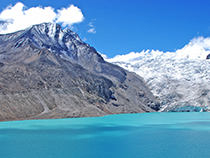
首页
陈效逑等近期发表论文Temperature and snowfall trigger alpine
时间:2015-10-27 12:00Rapid temperature increase and its impacts on alpine ecosystems in the Qinghai-Tibetan Plateau, the world's highest and largest plateau, are a matter of global concern. Satellite observations have revealed distinctly different trend changes and contradicting temperature responses of vegetation green-up dates, leading to broad debate about the Plateau's spring phenology and its climatic attribution. Large uncertainties in remote-sensing estimates of phenology significantly limit efforts to predict the impacts of climate change on vegetation growth and carbon balance in the Qinghai-Tibetan Plateau, which are further exacerbated by a lack of detailed ground observation calibration. Here, we revealed the spatiotemporal variations and climate drivers of ground-based herbaceous plant green-up dates using 72 green-up datasets for 22 herbaceous plant species at 23 phenological stations, and corresponding daily mean air temperature and daily precipitation data from 19 climate stations across eastern and southern parts of the Qinghai-Tibetan Plateau from 1981 to 2011. Results show that neither the continuously advancing trend from 1982 to 2011, nor a turning point in the mid to late 1990s as reported by remote-sensing studies can be verified by most of the green-up time series, and no robust evidence for a warmer winter-induced later green-up dates can be detected. Thus, chilling requirements may not be an important driver influencing green-up responses to spring warming. Moreover, temperature-only control of green-up dates appears mainly at stations with relatively scarce preseason snowfall and lower elevation, while coupled temperature and precipitation controls of green-up dates occur mostly at stations with relatively abundant preseason snowfall and higher elevation. The diversified interactions between snowfall and temperature during late winter to early spring likely determine the spatiotemporal variations of green-up dates. Therefore, prediction of vegetation growth and carbon balance responses to global climate change on the world's roof should integrate both temperature and snowfall variations.

